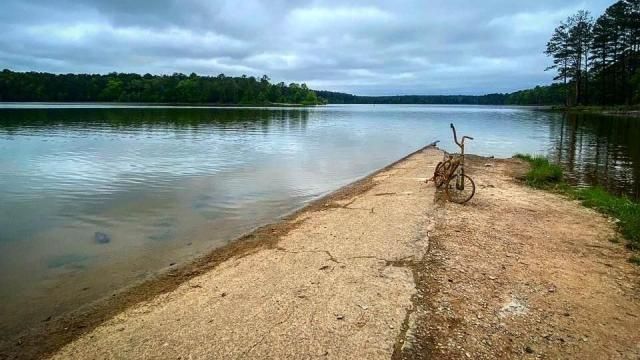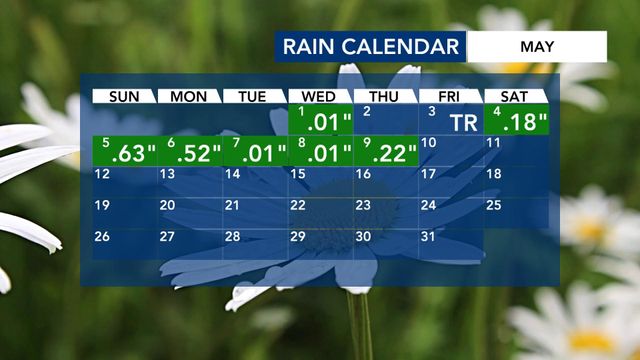Planes, trains, graves: NC lakes with history hidden beneath their waves
Thousands of people swim, fish and boat across the surface of North Carolina's large recreational lakes each year. However, many have no idea that just beneath the surface rests remnants of lost history, forgotten by time.
Kerr Lake has the remains of an old train beneath it--including the engine and tender. An entire airplane still rests beneath Lake Norman in Charlotte. Jordan Lake has an immense history buried beneath it, including the remains of a lost rural communities. One lake in the NC mountains has an entire ghost town that sometimes appears when water levels are low.
In a recent article, we explored the remains of an overgrown, abandoned segment of Old Highway 98 that goes into Falls Lake.
Now, let's explore the unexpected things hidden beneath North Carolina's manmade lakes.

1. Farms and grave sites beneath Jordan Lake
Jordan Lake is a large, manmade lake created in the 1960s. The surrounding area, known as the New Hope Valley, was prone to flooding, which helped develop rich soil that lured European settlers to farm the land as early as the 1700s. Remnants of those farms and homes are still beneath Jordan Lake.
Several rural communities grew within the New Hope Valley, frequently tormented by floods, especially when hurricanes crossed the state. After a particularly brutal hurricane in 1945, it was decided the New Hope Dam would be built to create a reservoir and help prevent future flooding.
Many rural communities were flooded after being acquired by the government for this project. Old abandoned homes still dot the woods around the lake.
Communities like Seaforth, Farrington, Pea Ridge and Friendship were impacted by the rising waters--some were completely flooded.
As generations of families lived in these communities, some of these farms had family cemeteries attached. Some families said they determined the cost of exhuming a grave was too much, or that they didn't want to disturb them-- meaning it's likely some older grave sites, perhaps even unmarked sites, were left behind.
With settlers lived on this land as far back as the 1700s, and members of the Tuscarora tribe living there before that, the New Hope Valley has a rich pre-Revolutionary history.
Like Falls Lake, several roads and even train tracks were flooded, leaving remnants beneath the surface. A satellite overview shows where the road disappears into the water, then reappears on the other side.

WRAL's Hidden Historian did a live stream exploring the remains of an abandoned road that vanishes into the lake, then comes out on the other side--just one remnant from the communities that once stood there. The road stretched out pretty far into the water, crumbling on either side.

2. Fontana Lake: Underwater ghost town of Judson
Sometimes, when water levels are low, you can actually see rooftops from the tallest remaining structures of the ghost town beneath Fontana Lake.
The small mountain town of Judson was flooded beneath Fontana Lake when the dam was first created in the 1940s to help create more hydroelectric power for WWII.
Thousands of acres were flooded in Swain County, forcing families to leave their homes behind. Many didn't even tear down their homes; they left them right where they were standing, hoping they could come back someday.
Many families also left behind precious family cemeteries, and can now no longer visit their loved ones unless they take a boat across Fontana Lake, or take a long hike into the wilderness that has consumed the ghost towns.
The full story of Judson, Fontana Lake and the Road to Nowhere is here.

3. Kerr Lake: Entire train remains from over a century ago
Long before Kerr Lake was created in 1952, a tall railroad trestle ran across the previous body of water, known as Nutbrush Creek.
In 1918, Engine Number 2 tried to cross the trestle, which had been weakened by a forest fire. The trestle collapsed, dropping Engine Number 2 into the creek below--where it remains to this very day.
Now a train engine, tender and three cars are hidden in the depths of Kerr Lake's 55,000 acres of water, created by damming the Roanoke River.
The accident led to two deaths--brothers who were on board the train when it fell.
4. Lake Norman: Airplane crash dates back to 1970s
Not everything beneath the surface of Lake Norman submerged in 1964. A decade after the creation of the lake, a plane sank in the summer of 1974.
The plane was discovered in 2013, when the Charlotte Fire Department said a dive team was doing practice drills when they noticed the submerged plane with their sonar equipment.
The plane is about 90 feet below the surface, and isn't visible. One family has said the plane could be theirs, recalling a tale of their own plane sinking in the 1970s on Lake Norman.
As with many other man-made lakes, many other historic structures and homes, bridges, mills, schools and even churches were on the land that became Lake Norman.
Podcast: Listen to lost mysteries beneath NC lakes
WRAL's Hidden Historian Heather Leah is a seventh-generation North Carolinian with a passion for preserving the state's culture and history. Listen as WRAL's Amanda Lamb and Heather Leah discuss mysteries and ghost towns hidden beneath North Carolina lakes in our latest podcast.










